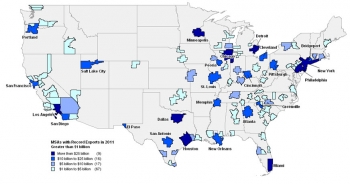Guest post from Natalie Soroka, Economist in the Office of Industry Analysis within the International Trade Administration
2011 was a good year for U.S. Metropolitan Area Exporters. Of the 367 metro areas with available data (due to Federal disclosure regulations), 206 saw record-high merchandise exports in 2011. Overall, exports from all metropolitan areas increased by 16 percent from 2010 to total $1.31 trillion in 2011. New York was the top exporter, accounting for $105.1 billion.
While export value is concentrated in the top metro areas (like New York, Houston, and Los Angeles), exports are an important economic driver nationwide. In 2011, 150 metro areas exported more than $1 billion of goods, thirteen of which reached this mark for the first time.
Overall, many areas experienced significant export growth in 2011, with exports increasing by more than $1 billion in 36 metro areas. Larger exporters such as Houston and New York showed the highest dollar growth, each growing by more than $20 billion compared to the previous year, but growth was not contained to big cities. Of the top 50 metro exporters in 2011, Corpus Christi showed the fastest growth, nearly doubling its goods exports since 2010. Much of this growth, along with other fast-rising metropolitan areas in Texas and Louisiana, was due to higher exports of petroleum and coal products. Higher commodity prices benefitted many cities in 2011, with major exporters of crops (Minneapolis, New Orleans, Portland), primary metals (Salt Lake City, New York), and petroleum and coal products (Houston, New Orleans, New York, Corpus Christi) showing high growth. In addition to commodities, exporters of manufactured goods such as chemicals (Houston) and transportation equipment (Detroit) showed high growth in 2011.Viewing exports from the metropolitan perspective is important, as these are concentrated areas for industries and economic activity. In 2011, 20 metropolitan areas represented more than 40 percent of their state’s total merchandise export activity, with three (Burlington, Honolulu, and Salt Lake City) accounting for more than 80 percent. This does not include metropolitan areas that cross state lines, such as New York (which includes portions of New Jersey), but nonetheless it is easy to see the importance of a metro area in its region. With this comes exposure to global events at the local level. Exports to the European Union accounted for more than a third of total goods exports in 25 metro areas in 2011, and for more than 20 percent in an additional 94 areas. This exceeds the 18 percent share nationwide, indicating that quite a few areas have a higher than average reliance on the EU market.
That said, other markets have been showing healthy demand for products from U.S. metro areas, including our trade agreement partners. While agreements may have only a marginal impact at the national level, they can have a large impact at the local level when an area has geographic proximity and economic or cultural ties to a particular country or region. For example, Miami exported $4.6 billion of goods to the CAFTA-DR region in 2011, representing 11 percent of the metro area’s exports to the world. Miami actually exported more to the six small CAFTA nations than it did to the European Union or our NAFTA partners (Canada and Mexico) combined. Similarly, you see that the CAFTA region represents important markets to other smaller metropolitan areas in the Southeastern U.S., such as Gadsden, Gulfport-Biloxi, Greensboro, Winson-Salem, Beaumont-Port Arthur, Macon, and Baton Rouge. While not yet in force in 2011, new FTA markets South Korea, Colombia, and Panama ranked among the top partners for several metro areas. Similar to the CAFTA region southeastern metropolitan areas ranked among the top exporters to Colombia and Panama, including Corpus Christi, Houston, Miami, New Orleans, Pascagoula, San Antonio, Beaumont, and Brownsville. Metropolitan areas in the northern U.S., such as Minneapolis, New York, Pittsburgh, Portland, and Seattle ranked among the top exporters to South Korea.
Find more information on MSA exports, including data and fact sheets for the top 50 exporting MSAs in 2011 on the Office of Industry Analysis home page.



Post new comment